038 of
150
BCATP: Aircraft - The North American Yale
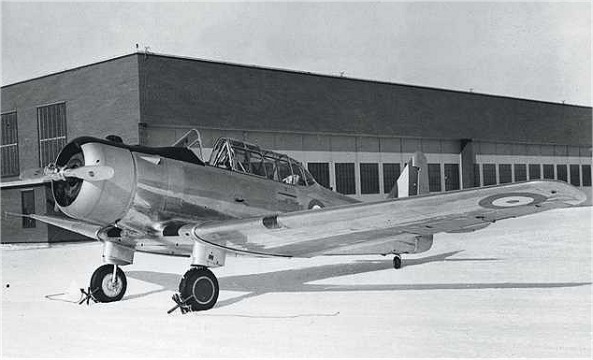 The
North American NA-64 Yale is an advanced World War II trainer aircraft
used by the Royal Canadian Air Force in the British Commonwealth Air Training
Plan. The Yales were acquired to be an intermediate trainer between the
Elementary School’s Tiger Moths and Fleet Finches and Service Flying Training
School’s Harvards. The RCAF soon realized that this step was unnecessary
and the Yales were relegated to duty as radio trainers. The Yale was not
originally intended for use in the `Plan,’ but when the opportunity came
up to acquire a fleet, the RCAF took advantage of the offer to ease the
shortage of dual control trainer aircraft.
The
North American NA-64 Yale is an advanced World War II trainer aircraft
used by the Royal Canadian Air Force in the British Commonwealth Air Training
Plan. The Yales were acquired to be an intermediate trainer between the
Elementary School’s Tiger Moths and Fleet Finches and Service Flying Training
School’s Harvards. The RCAF soon realized that this step was unnecessary
and the Yales were relegated to duty as radio trainers. The Yale was not
originally intended for use in the `Plan,’ but when the opportunity came
up to acquire a fleet, the RCAF took advantage of the offer to ease the
shortage of dual control trainer aircraft.
In 1940, the French Air Force was in the midst of receiving
an order for 230 Yale aircraft. When France fell to the German army, 113
aircraft had been delivered and another 119 were completed and awaiting
shipment from the North American Aviation plant in Los Angeles. The Germans
adopted the captured Yales for use as trainers in their air force. They
were in service until the availability of spare parts ran dry and the aircraft
became unservicable. The other 119 were taken by the RCAF under agreement
with North American Aviation.
At the end of World War II, the RCAF sold all remaining
Yales as scrap. Approximately 30 escaped the scrapper’s axe. Fifteen are
currently flightworthy.
Based on the North American NA-16 Harvard design, the
Yale was given a longer all-metal fuselage which was superior to the Harvard
fuselage. Other modifications included moving the fin backwards and engine
forward, the latter in order to maintain the aircraft’s centre of gravity.
Changes to the rudder and adoption of a wing design inferior to that of
the Harvard, as well as receiving a less powerful engine caused the Yale
to handle differently and with lower performance than the Harvard. A main
difference between the Yale and the Harvard is that the latter had retractable
landing gear.
The North American Yale was used at four Service Flying
Training Schools, No. 1 Flying Instructor School in Trenton, four Wireless
Schools and as an operational aircraft in one communications squadron and
one in a fighter squadron.
Yale 3462 is owned by the Commonwealth Air Training Plan
and is awaiting resources to finish restoration to flightworthy status.
It was taken on strength by the RCAF on November 29 1940 at No. 14
Service Flying Training School in Aylmer Ontario. It was redeployed to
No. 3 Wireless School in Winnipeg Manitoba. While at No. 14 SFTS, it was
involved in a Category C crash. When it was struck off strength by Canada’s
War Assets department on July 20 1943, the airframe had 2,110 hours on
it.
The North American Yale has a maximum/cruise speed of
166/146 mph. Its range is 730 miles at cruising speed and is capable of
five hours flying time. Its service ceiling is 17,500 feet. There was no
armament on RCAF models.
North American Aviation opened for business in 1928. It
was acquired by General Motor’s general aviation division in 1933 which
moved production facilities from Maryland to California and changed the
company’s focus to building training aircraft. During World War II, North
American expanded operations into Ohio, Texas and Kansas and became the
eleventh highest producer of military products. In 1948, General Motors
let North American go to become a public company. In 1967 North American
merged with Rockwell-Standard of which the new company became known as
North American Rockwell. In December 1996, Boeing acquired the company.
North American Aviation had an incredible history related
to the development and production of advanced aircraft, especially its
military versions. Other remarkable aircraft produced by North American
include the Harvard (T-6 Texan) trainer, P-51 Mustang fighter, B-25 Mitchell
bomber and F-86 Sabre Jet. North American also played a significant role
in development and flight of the X-15 aircraft, the Apollo Command and
Service Modules, the Saturn V rocket and the Space Shuttle.
Wikipedia – North American NA-64 Yale - https://en.wikipedia.org/wiki/North_American_NA-64_Yale
Wikipedia – North American Aviation - https://en.wikipedia.org/wiki/North_American_Aviation#World_War_II
Photo - By USAF - Canadian Forces, Public Domain, https://commons.wikimedia.org/w/index.php?curid=1627461
039 of
150
BCATP: A WWII Memory: Hewitt Elliott - Pilot - Part
1 of 2
In September of 2000, Hugh Elliott
submitted an email specifically answering questions related to the Commonwealth
Air Training Plan Museum’s oral history project. It was thorough and interesting
account in his time in the British Commonwealth Air Training Plan and RCAF
operations overseas.
429 Buffalo Squadron Crest
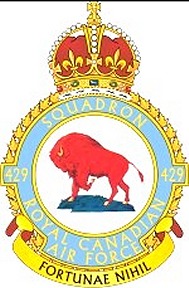 General
Information
General
Information
Flight Lieutenant Hewitt Elliott RCAF
Enlisted in 1941 at Hamilton
Home town and birth place was Hamilton.
My brother was also a pilot - F/L A. Elliott (deceased)
Training
Manning Depot Brandon Manitoba, 1941, one month.
It was a new experience and I didn't miss the family.
We lived in "tent city" for a while which
was rough but then moved to the exhibition buildings
and things were much better. I made friends with Neil Depew while in Brandon
and we stayed together and went overseas together. He was killed in action
in 1943. The tent city and exhibition buildings he refers were located
in what is known as the `Fair Grounds’ to residents of Brandon. During
World War II, the fair grounds and a significant part of southern Brandon
was home to the Canadian Army’s A4-Artillery School. Tents and exhibition
buildings were temporary for No. 2 Manning Depot pending completion of
renovations for the home of the airmen in Brandon.
Initial Training (No. 2 Initial Training School – Regina
Saskatchewan)
ITS at Regina during the Winter of 1941 (not sure of
dates, log book destroyed). Classes required were Navigation, Radio, Theory
of Flight, Engine Theory, Morse Code, Aircraft Recognition. I wanted to
be a pilot and during my initial training period i was selected to be a
pilot. Some others were not so lucky and were selected as Navigators etc.
Medical testing was rigorous - eyes for night vision, colour blindness,
etc. Also Link training to see if you had the aptitude for flying.
Specialized Training
(No. 15 Elementary Flying Training School – Regina
Saskatchewan)
Elementary Flying Training School (EFTS) was done at
Regina on Tiger Moths during the early spring of 1942 and lasted for about
three months and about 50 hours of flying.
No. 11 Service Flying Training School – Yorkton Saskatchewan
Service Flying Training School (SFTS) was done at Yorkton
Sask. on Cessna twin engine aircraft and lasted about four months and 150
hours. The instructors were excellent both at EFTS and SFTS and the morale
of the men was good. They couldn't wait to get overseas, in fact a New
Zealand pilot with the same name as mine who was selected to be an instructor
wanted to change places with me, He wanted to go o'seas so bad, Needless
to say I refused. I got my wings in September 1942 and proceeded on embarkation
leave in October. After leave we proceeded to Halifax and after 2 weeks
we went aboard the QE 1 with 13,000 soldiers and airmen, After 4 days of
calm seas we landed in Greenock Scotland and from there to holding depot
at Bournemouth.
Specialized Advanced Training in Rugby.
AFS (Advanced Flying School) training was done on Oxford
twin engine aircraft and was mainly to get in some more night and instrument
flying and get accustomed to English weather and flying conditions. The
living conditions were also different since we were living in Nissan huts
with no central heating and in the winter the small Quebec heater would
go out at night and the washing water would freeze until we got the stove
going again. The night life was different and most nights were spent in
the pubs playing darts or having a sing song. It was at this station that
I received my commission as a P/0 - from then on living conditions improved
and it was also here that I met my future wife. From here we went to OTU,
Operational Training Unit.
Operational Training Unit (OTU)
The OTU was at Wellsbourne Warwickshire, and the aircraft
I flew was the Wellington. At the OTU we were teamed up with a crew consisting
of a navigator, wireless op, bomb-aimer and a tail gunner. The Wellington
was a good rugged aircraft and was the mainstay of bomber command in 1943
until it was gradually replaced by the Halifax and Lancaster. At the OTU
we practiced day and night bombing (practice bombs) simulated raids, fighter
avoidance and in general got to work efficiently as a crew. I later became
a flying instructor on the Wimpy (Wellington) after I completed my tour
of ops.
Operations
After OTU I was posted to an operational squadron 429
in April 1943 .My first raid was as second (dickey) pilot with another
crew and was to Essen in the Rhur Valley, considered a hot target because
of its location and defenses. I did my first raid with my own crew to Dusseldorf
in the Rhur Valley witch wasn't very bad ``a piece of cake" as we called
it partly due to the fact that the (dam busters) had broke the dams and
flooded the Rhur Valley putting out most of the search lights, which were
a big worry for us because once you were "coned" it was difficult to get
out of let alone to see out of the cockpit. The weather cleared over Europe
for a week or so and in order to keep our hand in we did some training
"bullsyes" over London, These were simulated raids to give the search light
crews and ack-ack gunners some exercise.
Then I was posted to North Africa with 425 Squadron to
help with the invasion of Sicily and Italy, My earlier story (to be posted
online in Canada 150 vignette No. 40) about The Flying Turtle details my
flight to Africa and some of the conditions. We had one close call on one
of our trips. We were flying one aircraft at a time over the Messina straights
at 5000 feet when the search lights from both sides of the straights came
on and coned us, We could feel the exploding shells right under our aircraft
, We took evasive action and ended up close to the water and out of range
of the guns. Some hydraulic lines had been severed and a number of holes
in the fuselage but no one was hurt except the rear gunner who had a bump
on his head from the violent evasive action. The rest of the flight was
uneventful.
We returned to England by boat in October 1943 and I was
reclassified as an instructor at an OTU on Wellingtons at RAF Station Gaydon.
I remained at the OTU until my return to Canada in March 1945. My wife
did not return with me and I did not see her again until July 1946.
On my return to Canada I went back to College until my
wife joined me. I re-enlisted in 1949 in the RCAF and served until my retirement
in 1964.
Hugh Elliott passed away on June 11 2011 in Guelph
Ontario in his 92nd year. In the next Canada 150 Vignette we present Hugh’s
story of the Flying Turtle.
040 of
150
BCATP: A WW II Memory - Hewitt Elliott - Part 1 of
2 - The Flying Turtle
This is Part II of Hugh Elliott's
submisson to the British Commonwealth Air Training Plan Museum's Oral History
Project. Having completed BCATP training in Canada and Britain and operations
in a Wellington Bomber over Europe, Hugh and his crew face new challenges
in Northern Africa.
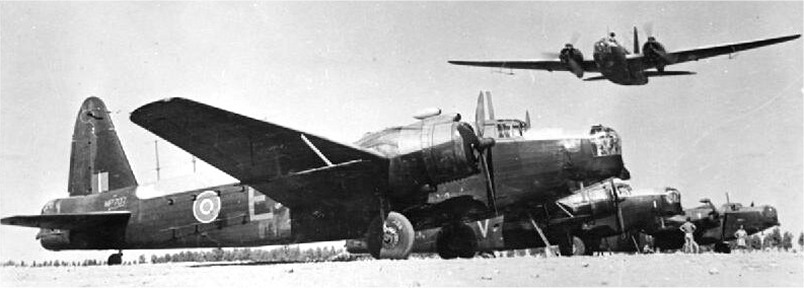
Vickers Wellington Mk. II bombers of No RAF No. 38 Squadron in Libya.
This little story of the Flying Turtle begins in the spring
of 1943 at the Wellington squadron in Yorkshire England. While on one of
my leaves from the squadron the rest of my crew volunteered me to go to
North Africa as a replacement crew for one the 3 squadrons that were already
there for the Africa Campaign, Since the wheels were already in motion
I could not back out. This meant that I had to change my plans to get married
(that is another story) since they wanted me to get ready to go right away
after embarkation leave.
My crew and I arrived at a base in southern England and
were equipped with tropical gear and khaki uniforms and a brand new Wellington
aircraft ,so new in fact that we had to put a number of flying hours on
it in order to iron out the bugs. Our route was from the southern tip of
England across the bay of Biscayne, which was patrolled by German long
range aircraft, around Spain and make landfall at Port Lyauti in Morocco,
North Africa. After refueling and equipping the engines with sand filters
we took off for Algeria which was to be our main base.
From our main base we were taken by truck to our squadron
which was on an old lake bed in the desert with sand runways. All the "buildings"
were tents of various sizes and the latrines were holes in the ground with
a fence around them. Not a very inspiring site having left the comforts
of England a couple of days ago. We even had to pitch our own tent which
held four and was to be our home for an indefinite period. Water was a
scarce commodity which had to be trucked in from a town about 10 miles
away, Needless to say showers were few and far between until were able
to rig up a pump to a well built by the Germans (the previous owners).
The next day I was "introduced to my aircraft," a beat
up dusty Wellington that had seen better days in contrast to the shiny
new one I brought down (no doubt a senior officer had that). We "air tested"
our new X for Xray and confirmed it was not in very good shape. A check
of the records showed that it had suffered some damage on a previous operation
and was very slow compared to other aircraft, however it did fly and the
engines sounded good.
After a few raids over Italy it was confirmed that it
was slow with a bomb load but seemed ok after we dropped our bombs and
we could keep up with the rest of the squadron .I then suggested that we
should take off a little earlier than everybody else in order to get there
at the same time, The CO granted my request. My bomb aimer suggested we
should name the aircraft the Turtle, We all agreed and had an "artist"
on the squadron design and paint a picture of a turtle with wings carrying
a bomb and the inscription "slow but sure." A picture of a bomb was added
for each operation the aircraft made. The whole operation was such a success
that after about 46 trips we decided that the "old lady" deserved the DFC
so it was painted on her nose along with the bombs. It was pointed out
later that the stripes on the DFC were angled the wrong way but I don't
think the old lady would mind.
The Flying Turtle was retired when her engines were "time
expired" and due for an engine change. After the war I heard a group of
children commenting on a comic book about war exploits and about a flying
turtle, Sure enough it was about my aircraft. A war correspondent that
was covering the North Africa campaign heard the story and submitted it.
Along with a couple of pictures.
Hope this is what you want, If not I will try again. Good
luck on your project.
Ex F/L H. Elliott CD
2000/09/04

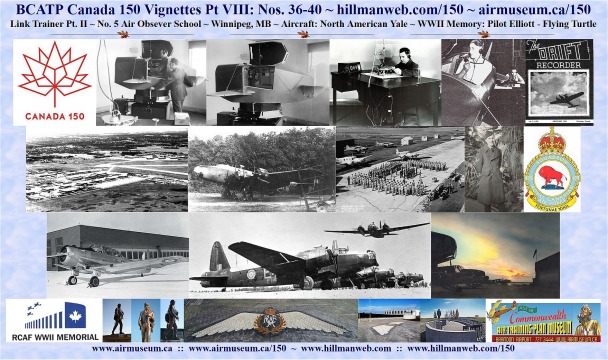
Click for full-size collage poster

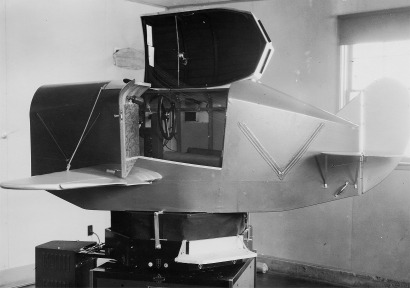
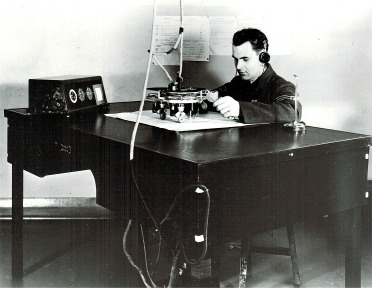
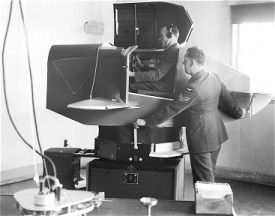
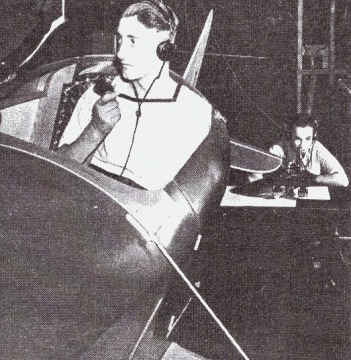 ITS JUST
A STONE'S THROW TO LAKE ONTARIO but hundreds of blue-clad future Fleet
Air Arm pilots now training in Canada seldom see it except from the air.
Below them, as they roar out over the lake on training flights lies Kingston's
31 Service Flying Training School, an RAF station that is unique. Here
Royal Air Force personnel headed by Group Capt. Le Poer trench train Royal
Navy men to fly.
ITS JUST
A STONE'S THROW TO LAKE ONTARIO but hundreds of blue-clad future Fleet
Air Arm pilots now training in Canada seldom see it except from the air.
Below them, as they roar out over the lake on training flights lies Kingston's
31 Service Flying Training School, an RAF station that is unique. Here
Royal Air Force personnel headed by Group Capt. Le Poer trench train Royal
Navy men to fly.
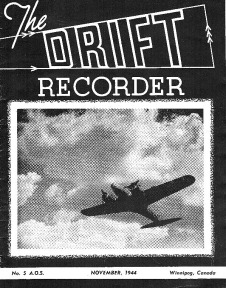 No.
5 Air Observers School opened on January 6 1941. It provided instruction
for navigators with training under the British Commonwealth Air Training
Plan for 1,575 days, closing on February 17 1945. It took over the location
of No. 14 Elementary Service Flying School which was moved to Portage la
Prairie Manitoba. No. 5 AOS was located in Winnipeg Manitoba on 60 acres
of land at Stevenson Field on what is now the Winnipeg James Armstrong
Richardson International Airport .
No.
5 Air Observers School opened on January 6 1941. It provided instruction
for navigators with training under the British Commonwealth Air Training
Plan for 1,575 days, closing on February 17 1945. It took over the location
of No. 14 Elementary Service Flying School which was moved to Portage la
Prairie Manitoba. No. 5 AOS was located in Winnipeg Manitoba on 60 acres
of land at Stevenson Field on what is now the Winnipeg James Armstrong
Richardson International Airport .
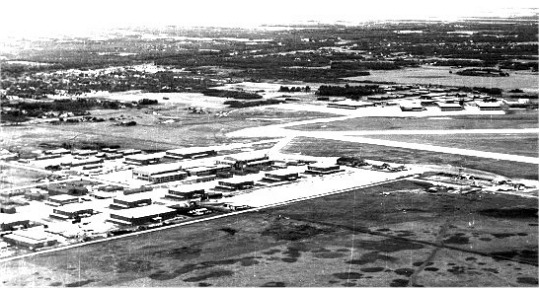
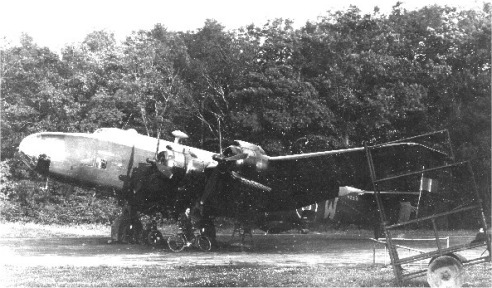
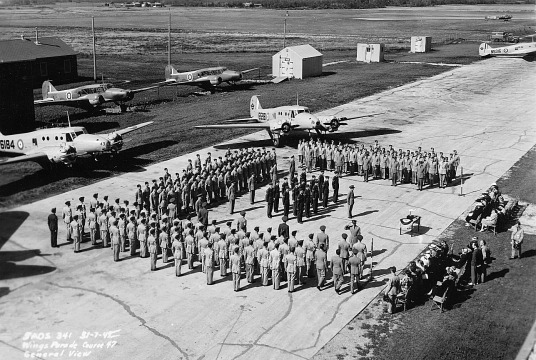 .
.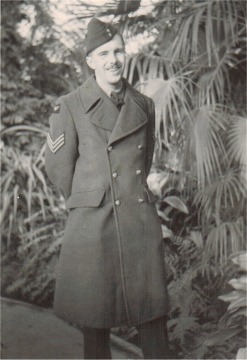
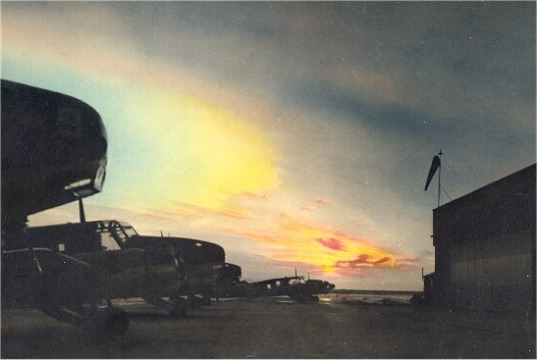
 The
North American NA-64 Yale is an advanced World War II trainer aircraft
used by the Royal Canadian Air Force in the British Commonwealth Air Training
Plan. The Yales were acquired to be an intermediate trainer between the
Elementary School’s Tiger Moths and Fleet Finches and Service Flying Training
School’s Harvards. The RCAF soon realized that this step was unnecessary
and the Yales were relegated to duty as radio trainers. The Yale was not
originally intended for use in the `Plan,’ but when the opportunity came
up to acquire a fleet, the RCAF took advantage of the offer to ease the
shortage of dual control trainer aircraft.
The
North American NA-64 Yale is an advanced World War II trainer aircraft
used by the Royal Canadian Air Force in the British Commonwealth Air Training
Plan. The Yales were acquired to be an intermediate trainer between the
Elementary School’s Tiger Moths and Fleet Finches and Service Flying Training
School’s Harvards. The RCAF soon realized that this step was unnecessary
and the Yales were relegated to duty as radio trainers. The Yale was not
originally intended for use in the `Plan,’ but when the opportunity came
up to acquire a fleet, the RCAF took advantage of the offer to ease the
shortage of dual control trainer aircraft.
 General
Information
General
Information

